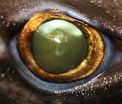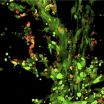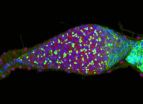(Press-News.org) Using NASA's Hubble Space Telescope, a team of astronomers has spotted a star system that could have left behind a "zombie star" after an unusually weak supernova explosion.
A supernova typically obliterates the exploding white dwarf, or dying star. On this occasion, scientists believe this faint supernova may have left behind a surviving portion of the dwarf star -- a sort of zombie star.
While examining Hubble images taken years before the stellar explosion, astronomers identified a blue companion star feeding energy to a white dwarf, a process that ignited a nuclear reaction and released this weak supernova blast. This supernova, Type Iax, is less common than its brighter cousin, Type Ia. Astronomers have identified more than 30 of these mini-supernovas that may leave behind a surviving white dwarf.
"Astronomers have been searching for decades for the star systems that produce Type Ia supernova explosions," said scientist Saurabh Jha of Rutgers University in Piscataway, New Jersey. "Type Ia's are important because they're used to measure vast cosmic distances and the expansion of the universe. But we have very few constraints on how any white dwarf explodes. The similarities between Type Iax's and normal Type Ia's make understanding Type Iax progenitors important, especially because no Type Ia progenitor has been conclusively identified. This discovery shows us one way that you can get a white dwarf explosion."
The team's results will appear in the Thursday, Aug. 7 edition of the journal Nature.
The weak supernova, dubbed SN 2012Z, resides in the host galaxy NGC 1309 which is 110 million light-years away. It was discovered in the Lick Observatory Supernova Search in January 2012. Luckily, Hubble's Advanced Camera for Surveys also observed NGC 1309 for several years prior the supernova outburst, which allowed scientists to compare before-and-after images.
Curtis McCully, a graduate student at Rutgers and lead author of the team's paper, sharpened the Hubble pre-explosion images and noticed a peculiar object near the location of the supernova.
"I was very surprised to see anything at the location of the supernova. We expected the progenitor system would be too faint to see, like in previous searches for normal Type Ia supernova progenitors. It is exciting when nature surprises us," McCully said.
After studying the object's colors and comparing with computer simulations of possible Type Iax progenitor systems, the team concluded they were seeing the light of a star that had lost its outer hydrogen envelope, revealing its helium core.
The team plans to use Hubble again in 2015 to observe the area, giving time for the supernova's light to dim enough to reveal any possible zombie star and helium companion to confirm their hypothesis.
"Back in 2009, when we were just starting to understand this class, we predicted these supernovae were produced by a white dwarf and helium star binary system," said team member Ryan Foley of the University of Illinois at Urbana-Champaign, who helped identify Type Iax supernovae as a new class. "There's still a little uncertainty in this study, but it is essentially validation of our claim."
One possible explanation for the unusual nature of SN 2012Z is that a game of seesaw ensued between the bigger and smaller of the star pair. The more massive star evolved more quickly to expand and dump its hydrogen and helium onto the smaller star. The rapidly evolving star became a white dwarf. The smaller star bulked up, grew larger and engulfed the white dwarf. The outer layers of this combined star were ejected, leaving behind the white dwarf and the helium core of the companion star. The white dwarf siphoned matter from the companion star until it became unstable and exploded as a mini-supernova, leaving behind a surviving zombie star.
Astronomers already have located the aftermath of another Type Iax supernova blast. Images were taken with Hubble in January 2013 of supernova 2008ha, located 69 million light-years away in the galaxy UGC 12682, in more than four years after it exploded. The images show an object in the area of the supernova that could be the zombie star or the companion. The findings will be published in The Astrophysical Journal.
"SN 2012Z is one of the more powerful Type Iax supernovae and SN 2008ha is one of the weakest of the class, showing that Type Iax systems are very diverse," explained Foley, lead author of the paper on SN 2008ha. "And perhaps that diversity is related to how each of these stars explodes. Because these supernovae don't destroy the white dwarf completely, we surmise that some of these explosions eject a little bit and some eject a whole lot."
The astronomers hope their new findings will spur the development of improved models for these white dwarf explosions and a more complete understanding of the relationship between Type Iax and normal Type Ia supernovae and their corresponding star systems.
INFORMATION:
The Hubble Space Telescope is a project of international cooperation between NASA and the European Space Agency. NASA's Goddard Space Flight Center in Greenbelt, Maryland, manages the telescope. The Space Telescope Science Institute (STScI) in Baltimore conducts Hubble science operations. STScI is operated for NASA by the Association of Universities for Research in Astronomy, Inc., in Washington.
For images and more information about Hubble, visit:
http://www.nasa.gov/hubble
and
http://hubblesite.org/news/2014/32
NASA's Hubble finds supernova star system linked to potential 'zombie star'
2014-08-06
ELSE PRESS RELEASES FROM THIS DATE:
New research links tornado strength, frequency to climate change
2014-08-06
TALLAHASSEE, Fla. — New research by a Florida State University geography professor shows that climate change may be playing a key role in the strength and frequency of tornadoes hitting the United States.
Published Wednesday in the journal Climate Dynamics, Professor James Elsner writes that though tornadoes are forming fewer days per year, they are forming at a greater density and strength than ever before. So, for example, instead of one or two forming on a given day in an area, there might be three or four occurring.
"We may be less threatened by tornadoes on a ...
Fipronil and imidacloprid reduce honeybee mitochondrial activity
2014-08-06
PENSACOLA, Fla. — New research published in Environmental Toxicology and Chemistry addresses the effects of two broad-spectrum systemic insecticides, fipornil and imidacloprid, on honeybees. These insecticides are widely used in agriculture, and the authors conclude that fipronil and imidacloprid are inhibitors of mitochondrial bioenergetics, resulting in depleted cell energy. This action can explain the toxicity of these compounds for honeybees.
Scientists are urgently trying to determine the causes of colony collapse disorder and the alarming population declines of ...
Community religious beliefs influence whether wives work outside home, Baylor study finds
2014-08-06
Married women who live in communities in which a higher proportion of the population belongs to conservative religious traditions — such as evangelical or Mormon — are more likely to choose not to work outside the home, even if the women are not members of those faith groups, according to a Baylor University study.
The study — "Work-Family Conflict: The Effects of Religious Context on Married Women's Participation in the Labor Force" — appears in the journal Religions in a special issue, "Religion, Spirituality, and Family Life."
While previous research has shown individual ...
Photon hunting in the twilight zone
2014-08-06
The eyes of deep-sea bioluminescent sharks have a higher rod density when compared to non-bioluminescent sharks, according to a study published August 6, 2014 in the open-access journal PLOS ONE by Julien M. Claes, postdoctoral researcher from the FNRS at Université catholique de Louvain (Belgium), and colleagues. This adaptation is one of many these sharks use to produce and perceive bioluminescent light in order to communicate, find prey, and camouflage themselves against predators.
The mesopelagic twilight zone, or about 200-1000 meters deep in the sea, is a vast, ...
Young loggerhead turtles not going with the flow
2014-08-06
Juvenile loggerhead turtles swim into oncoming ocean currents, instead of passively drifting with them, according to a study published August 6, 2014 in the open-access journal PLOS ONE by Donald Kobayashi from National Oceanic and Atmospheric Administration and colleagues.
After loggerhead turtle hatchlings leave nesting beaches, they live in the ocean for 7-12 years before migrating to coastal habitats. Juvenile loggerhead turtles have good swimming abilities, but scientists aren't sure if they passively drift in ocean currents or actively swim. Combining turtle movement ...
HSCI researchers identify another potential ALS treatment avenue
2014-08-06
Cambridge, MA, Aug 6 - A series of studies begun by Harvard Stem Cell Institute (HSCI) scientists eight years ago has lead to a report published today that may be a major step forward in the quest to develop real treatments for amyotrophic lateral sclerosis, ALS, or Lou Gehrig's disease.
The findings by Harvard professor of Stem Cell and Regenerative Biology (HSCRB) Kevin Eggan and colleagues also has produced functionally identical results in human motor neurons in a laboratory dish and in a mouse model of the disease, demonstrating that the modeling of human disease ...
Dr. Brenna Anderson publishes commentary in BJOG
2014-08-06
Brenna Anderson, MD, of the Division of Maternal-Fetal Medicine at Women & Infants of Rhode Island and an associate professor of obstetrics and gynecology at The Warren Alpert Medical School of Brown University, has published a commentary in the current issue of BJOG: An International Journal of Obstetrics and Gynaecology, now available online. The commentary is entitled "The time has come to consider neonatal outcomes when designing embryo transfer policies."
Dr. Anderson offers her commentary in response to an article in the same issue by Kamphius et al. in which the ...
Brain tumors fly under the body's radar like stealth jets, new U-M research suggests
2014-08-06
ANN ARBOR, Mich. — Brain tumors fly under the radar of the body's defense forces by coating their cells with extra amounts of a specific protein, new research shows.
Like a stealth fighter jet, the coating means the cells evade detection by the early-warning immune system that should detect and kill them. The stealth approach lets the tumors hide until it's too late for the body to defeat them.
The findings, made in mice and rats, show the key role of a protein called galectin-1 in some of the most dangerous brain tumors, called high grade malignant gliomas. A research ...
NIST ion duet offers tunable module for quantum simulator
2014-08-06
BOULDER, Colo -- Physicists at the National Institute of Standards and Technology (NIST) have demonstrated a pas de deux of atomic ions that combines the fine choreography of dance with precise individual control.
NIST's ion duet, described in the August 7 issue of Nature, is a component for a flexible quantum simulator that could be scaled up in size and configured to model quantum systems of a complexity that overwhelms traditional computer simulations. Beyond simulation, the duet might also be used to perform logic operations in future quantum computers, or as a quantum-enhanced ...
Stowers researchers reveal molecular competition drives adult stem cells to specialize
2014-08-06
KANSAS CITY, MO — Adult organisms ranging from fruit flies to humans harbor adult stem cells, some of which renew themselves through cell division while others differentiate into the specialized cells needed to replace worn-out or damaged organs and tissues.
Understanding the molecular mechanisms that control the balance between self-renewal and differentiation in adult stem cells is an important foundation for developing therapies to regenerate diseased, injured or aged tissue.
In the current issue of the journal Nature, scientists at the
Stowers Institute for ...






